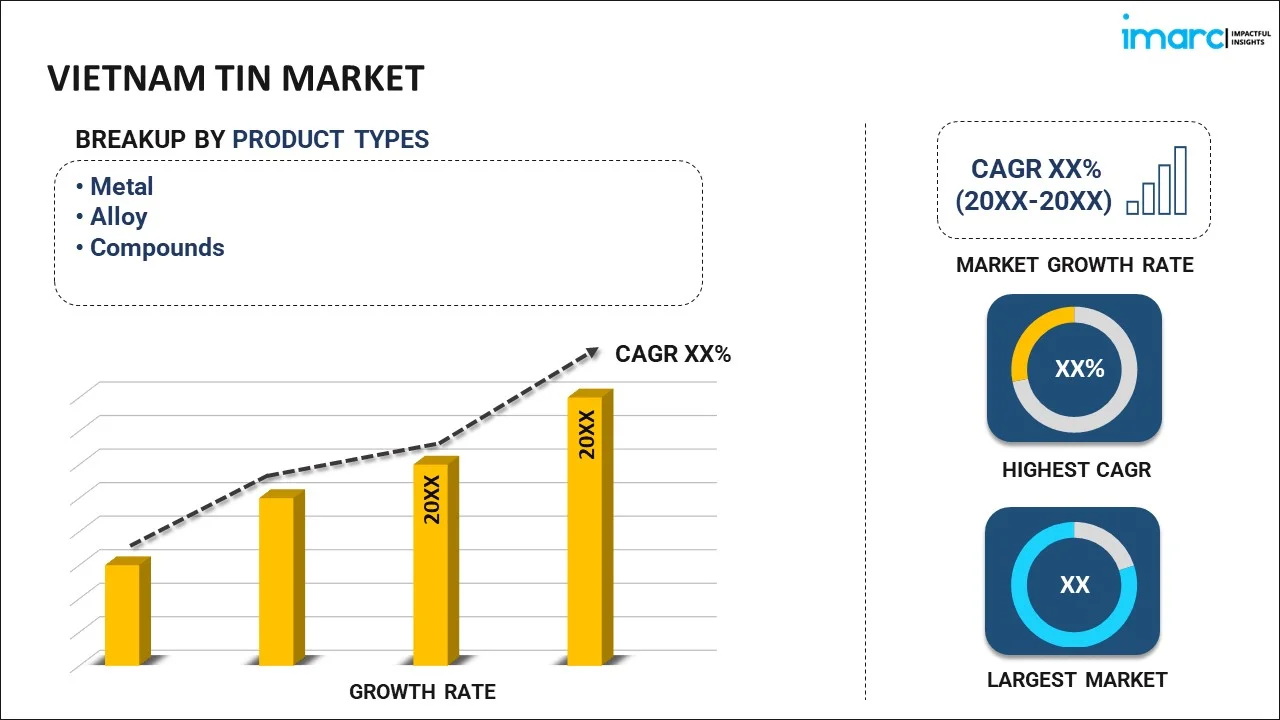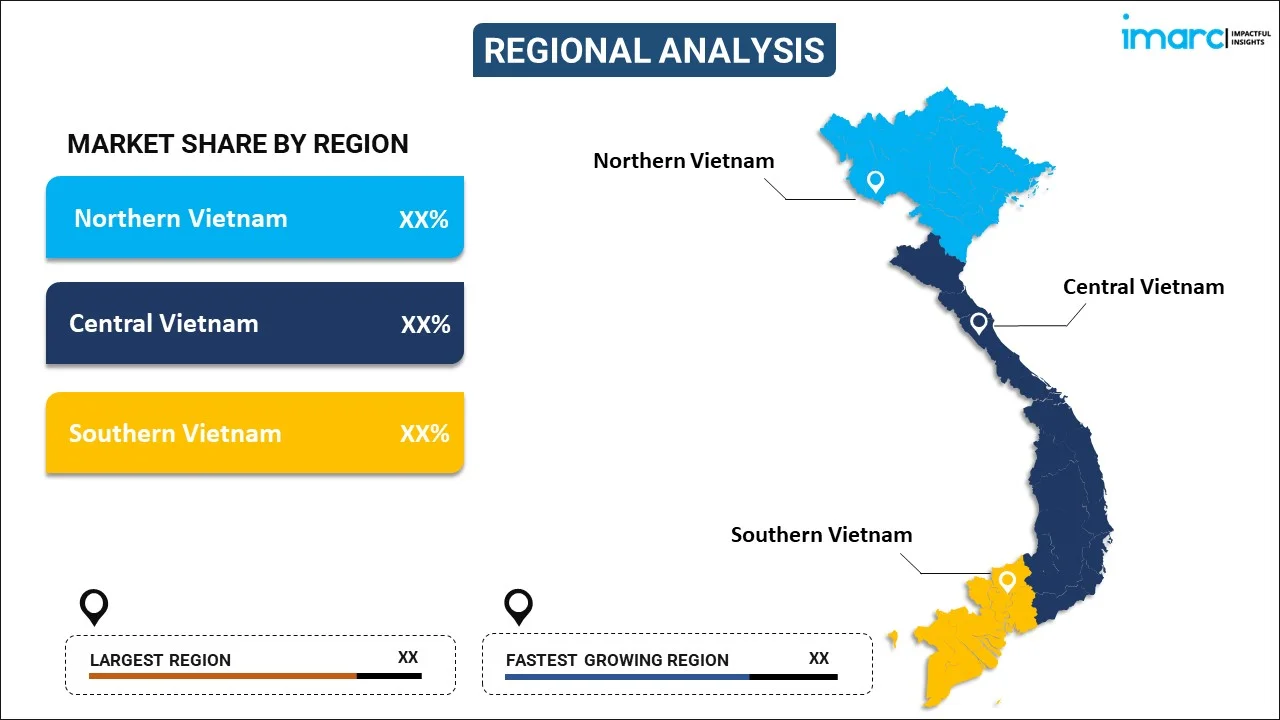
Vietnam Tin Market Report by Product Type (Metal, Alloy, Compounds), Application (Soldering, Tin Plating, Chemicals, and Others), End Use Industry (Automotive, Electronics, Packaging (Food and Beverages), Glass, and Others), and Region 2025-2033
Market Overview:
Vietnam tin market size reached 2.1 Kilo Tonnes in 2024. Looking forward, IMARC Group expects the market to reach 2.2 Kilo Tonnes by 2033. The expanding end-use industries, including electronics, soldering, packaging, and chemicals, along with the rising utilization of tin in electronic devices or the automotive sector, is driving the market.
|
Report Attribute
|
Key Statistics
|
|---|---|
|
Base Year
|
2024
|
|
Forecast Years
|
2025-2033
|
|
Historical Years
|
2019-2024
|
|
Market Size in 2024
|
2.1 Kilo Tonnes |
|
Market Forecast in 2033
|
2.2 Kilo Tonnes |
Tin is a chemical element with the symbol Sn and atomic number 50. It is a silvery-white, malleable metal that resists corrosion from water, making it an essential material for a variety of applications. Tin is used extensively in alloys, most notably in bronze, which is an alloy of copper and tin. In addition to alloys, tin is utilized in the production of tinplate, which is a steel sheet coated with a thin layer of tin. This tin coating imparts corrosion resistance to the steel, extending its lifespan and making it suitable for the manufacturing of cans used for food storage. Moreover, tin is used in the electronics industry, where it serves as a solder for joining electrical components together. Tin also plays a role in the production of glass, as it is used to coat glass during the float glass process, resulting in a smooth, shiny surface.
Vietnam Tin Market Trends:
The tin market in Vietnam is influenced by several key drivers, which collectively shape its dynamics and trends. Firstly, regional demand for tin has been steadily rising due to its extensive use in the electronics industry. This is primarily driven by the growing popularity of electronic devices and the increasing demand for advanced circuitry in smartphones, laptops, and other gadgets. Furthermore, the automotive sector plays a significant role in driving tin market growth, as tin is a crucial component in soldering materials used in vehicle electronics and batteries. Additionally, environmental concerns have fueled the demand for tin in the renewable energy sector, where it is employed in the production of photovoltaic panels and energy-efficient lighting systems. In conclusion, the tin market in Vietnam is intricately connected to various economic and technological factors that collectively shape its trajectory. As demand continues to rise across multiple industries and supply dynamics remain subject to various external factors, the tin market remains dynamic and responsive to these evolving drivers.
Vietnam Tin Market Segmentation:
IMARC Group provides an analysis of the key trends in each segment of the market, along with forecasts at the country level for 2025-2033. Our report has categorized the market based on product type, application, and end use industry.
Product Type Insights:

To get more information on this market, Request Sample
- Metal
- Alloy
- Compounds
The report has provided a detailed breakup and analysis of the market based on the product type. This includes metal, alloy, and compounds.
Application Insights:
- Soldering
- Tin Plating
- Chemicals
- Others
A detailed breakup and analysis of the market based on the application have also been provided in the report. This includes soldering, tin plating, chemicals, and others.
End Use Industry Insights:
- Automotive
- Electronics
- Packaging (Food and Beverages)
- Glass
- Others
The report has provided a detailed breakup and analysis of the market based on the end use industry. This includes automotive, electronics, packaging (food and beverages), glass, and others.
Regional Insights:

- Northern Vietnam
- Central Vietnam
- Southern Vietnam
The report has also provided a comprehensive analysis of all the major regional markets, which include Northern Vietnam, Central Vietnam, and Southern Vietnam.
Competitive Landscape:
The market research report has also provided a comprehensive analysis of the competitive landscape. Competitive analysis such as market structure, key player positioning, top winning strategies, competitive dashboard, and company evaluation quadrant has been covered in the report. Also, detailed profiles of all major companies have been provided.
Vietnam Tin Market Report Coverage:
| Report Features | Details |
|---|---|
| Base Year of the Analysis | 2024 |
| Historical Period | 2019-2024 |
| Forecast Period | 2025-2033 |
| Units | Kilo Tonnes |
| Scope of the Report | Exploration of Historical and Forecast Trends, Industry Catalysts and Challenges, Segment-Wise Historical and Predictive Market Assessment:
|
| Product Types Covered | Metal, Alloy, Compounds |
| Applications Covered | Soldering, Tin Plating, Chemicals, Others |
| End Use Industries Covered | Automotive, Electronics, Packaging (Food and Beverages), Glass, Others |
| Regions Covered | Northern Vietnam, Central Vietnam, Southern Vietnam |
| Customization Scope | 10% Free Customization |
| Post-Sale Analyst Support | 10-12 Weeks |
| Delivery Format | PDF and Excel through Email (We can also provide the editable version of the report in PPT/Word format on special request) |
Key Benefits for Stakeholders:
- IMARC’s industry report offers a comprehensive quantitative analysis of various market segments, historical and current market trends, market forecasts, and dynamics of the Vietnam tin market from 2019-2033.
- The research report provides the latest information on the market drivers, challenges, and opportunities in the Vietnam tin market.
- Porter's five forces analysis assist stakeholders in assessing the impact of new entrants, competitive rivalry, supplier power, buyer power, and the threat of substitution. It helps stakeholders to analyze the level of competition within the Vietnam tin industry and its attractiveness.
- Competitive landscape allows stakeholders to understand their competitive environment and provides an insight into the current positions of key players in the market.
Key Questions Answered in This Report
The tin market in Vietnam reached 2.1 Kilo Tonnes in 2024.
The Vietnam tin market is projected to reach 2.2 Kilo Tonnes by 2033.
Rising demand for solder in electronics, expanding solar power installations, growing battery manufacturing, and Indonesia’s export restrictions are pushing Vietnam’s tin production. Favorable government policies and investment in mining infrastructure also support domestic output, making Vietnam a key player in Southeast Asia’s tin supply chain.
Need more help?
- Speak to our experienced analysts for insights on the current market scenarios.
- Include additional segments and countries to customize the report as per your requirement.
- Gain an unparalleled competitive advantage in your domain by understanding how to utilize the report and positively impacting your operations and revenue.
- For further assistance, please connect with our analysts.
 Request Customization
Request Customization
 Speak to an Analyst
Speak to an Analyst
 Request Brochure
Request Brochure
 Inquire Before Buying
Inquire Before Buying




.webp)




.webp)












